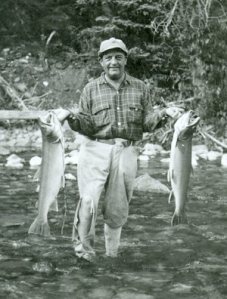As the number of native bull trout in the Flathead continues to wither, there seems to be a lot of selective memory loss happening among our local sportsmen. After talking about how important the trophy fishery for large bull trout used to be for Flathead Anglers, we heard back from a few that fishing for bull trout just never was a very popular fishery like we made it out to be.
I have talked to many of the old-time anglers in the Flathead and listened to their tales of anticipation for the opening of the river just about the time the large bull trout, which many called “Dolly Varden”, were on the move. Like inland salmon, bull trout make an annual migration up our rivers and streams every spring traveling up to 130 miles over many months to spawn in tributaries in the U.S. and Canadian Flathead. Like many of our brother anglers on the west coast, this annual migration used to be widely anticipated by local fishermen. Up and down the Flathead, anglers turned out at their favorite named holes as soon as the fish were in the river in hopes of landing trophy bull trout that could reach over 20 pounds.
Looking through some historical articles, I found many articles from about this time of year referring to anticipation generated by the annual run of “Dolly Varden” in our waters. I was struck by this article from the Flathead Outdoors column in the Kalispell Daily Inter Lake from June 22, 1958:
A number of local fishermen worried for weeks that the June 15 opening date of the Flathead River would be too late for good Dolly Varden (bull trout) fishing. Apparently, however, the big trout didn’t know they were supposed to confirm suspicions of the dubious fishermen by refusing to bite on opening day. Result was that Sunday, the first day of the season, many a fishermen caught one or two nice Dollies. Muggs Huff reported taking a 12-pounder, Norm Beyer, recently of Hamilton and fishing in Flathead waters for the first time, landed a beauty weighing eight pounds. In addition, we saw several unidentified anglers leaving the river with one or two trout that were nearly a yard long.
The Flathead area is the only spot in Montana that produces Dolly Vardens like these. The fishing public should work with the State Fish and Game Department in keeping this popular large trout for all time in Flathead waters.
Now it’s that time of year again. The rivers and streams are up and a few remaining native bull trout are attempting to make their way past the increasingly-large gauntlet of non-native lake trout and northern pike on an impressive migration that will take some of them north all the way to the wilds of Canada to fulfill an ever-harder quest to perpetuate their species. What’s missing now, and for the last few decades is the cadre of anglers that lined the banks of the Flathead River and its tributaries. Just fishing for the only local trophy trout in our rivers is now an illegal activity punishable by hefty fines. Bull trout are now listed as a Threatened Species by the federal government and fewer than 3,000 adults now inhabit Flathead Lake, the North and Middle forks.
We still have a very narrow window in which it will be possible to increase the numbers of these popular and spectacular native fish. It will take dedication, it will take sacrifice and yes, it will take money, but by removing some of those non-native lake trout that prey on our native bull trout and cutthroats, we can once again treat ourselves to that feeling of anticipation and excitement every spring that was felt by “Muggs” and “Norm” as they cast to trophy “Dollies” along our home waters.















